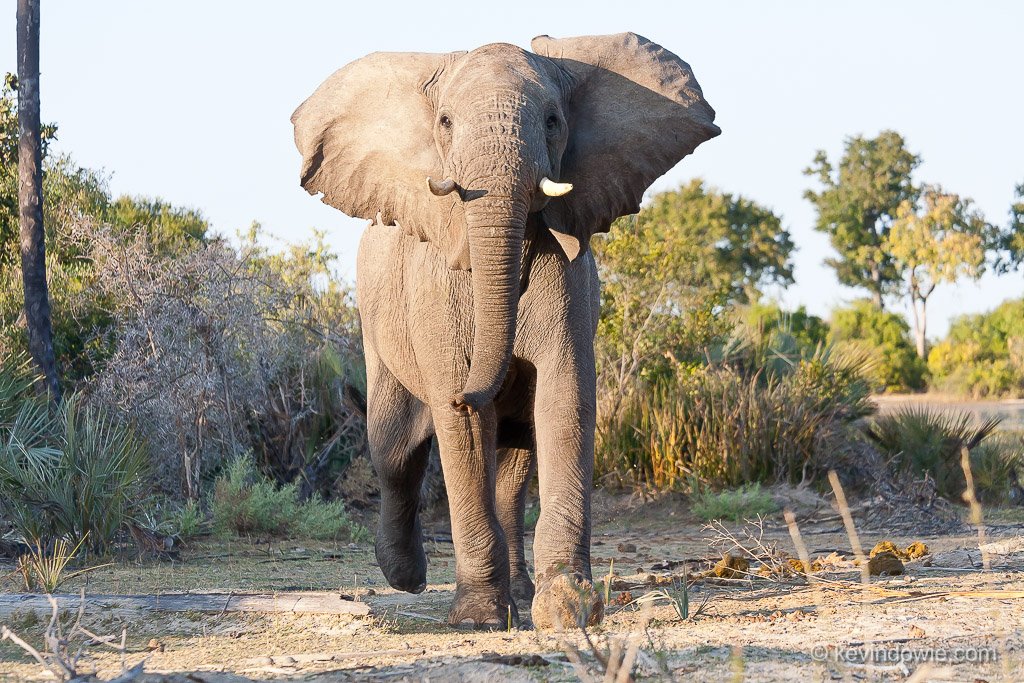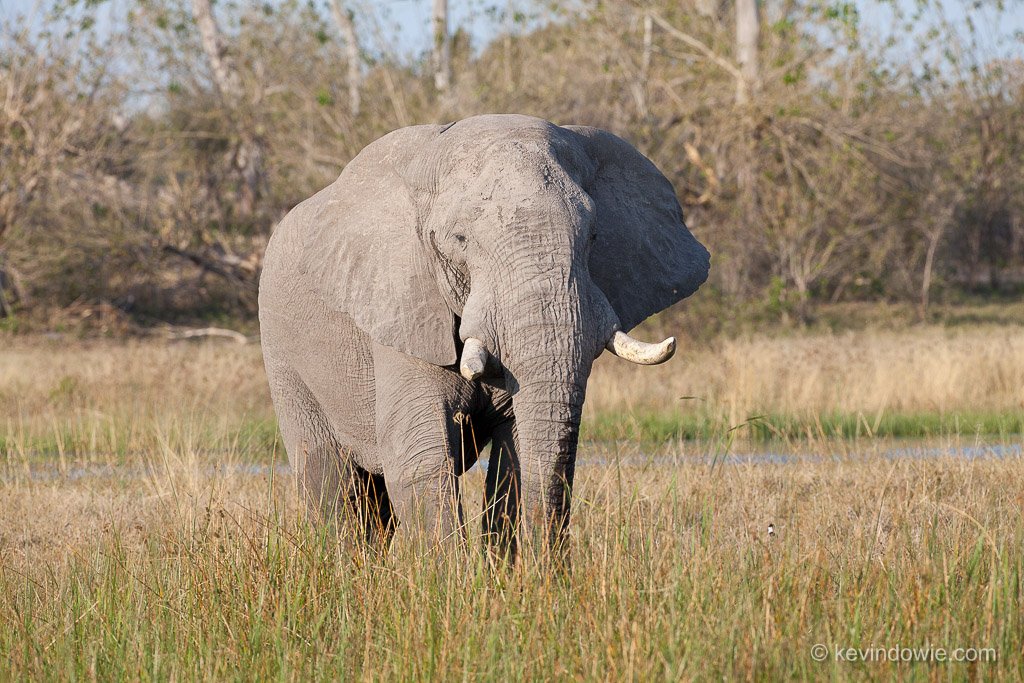During July-August, 2009, I was fortunate enough to participate in a photographic safari/workshop in the renowned Okavango Delta region of Botswana. This trip included game viewing drives in four-wheel-drive vehicles, travelling the waterways and channels of the delta in both motorized boats and man-powered canoes (mokoros) and also flying in helicopters. Each of these provided wonderful opportunities to view the wildlife and also the environment in which it lives.
Of the numerous species observed, one of the most fascinating was the elephants which we sighted in significant numbers and at close range.

An adult elephant flares its ears as it approaches the camera. The shot is made more dramatic by the low camera angle. Early morning, Kwetsani camp.

Savuti Channel
A herd of elephants cross the Savuti Channel. (This shot does not show the entire herd, which totalled 2 or 3 times the number shown here) One of our most memorable encounters with elephants occurred at Savuti camp. Excellent rainfall in the Angolan highlands, which feed the rivers which in turn flow into the delta, meant the Savuti channel was high with water for the first time in approximately 20 years.
Immediately adjacent to our camp, a large herd of elephants assembled at the water’s edge to drink before crossing the channel en masse. This gave us the opportunity to observe some wonderful interaction between members of the herd with females leading their calves, some of them quite young, through the water. Bulls challenged each other, testing their strength and asserting themselves, trying to establish dominance. Other herd members spent their time splashing around in the water, playing and simply having fun.
This episode occurred during the early afternoon when we were spending some “downtime” eating lunch, catching up on diary entries, recharging camera batteries, transferring files on laptop computers, etc. However, as events unfolded, we quickly got the cameras out and started getting some shots. At one point, I realized that the best angle on some of the elephants was actually to be had from the toilet/bathroom which had a generously sized glassless window. Ironically this provided a really good viewpoint!

Whilst elephants drink huge quantities of water and wash themselves, at times it seems they simply love to play in the water. I took numerous shots of elephants just enjoying splashing around, see the slide show/galleries link below for more.

A pair of bulls decide to test each other out, this encounter lasted for several minutes as each animal attempted to assert its dominance.

A bull elephant assumes a sexually dominant position over its rival. This contest continued for several minutes. see the slide show/galleries link below for more.

Chitabe.
Chitabe provided some fine elephant sightings and elephant numbers were good. This bull elephant, photographed in the late afternoon, was one of the largest we saw. I understand that elephants can get to 6.5 tons in weight, this magnificent fellow must have been close to that. Notice the fluid issuing from the gland between the eye and the ear, this indicates that the animal is in “must”, in other words, he’s ready to mate. During this period the bull becomes increasingly irritable and gives off a distinctive odour which is noticeable even to the human nose at quite a distance.
Photographed from a respectful distance with the 500mm telephoto lens as a bull in season can be unpredictable and dangerous.
**** For further images, check out the Botswana image gallery. *****
A few Elephant Facts.
The largest surviving land animals on the planet, elephants are highly intelligent and sociable. They can live to 70 years in the wild and can inhabit a variety of different habitats from open grassland to semi-desert to forests. Elephants display a curiosity for, or a recognition of, the bones of dead elephants and have been observed picking up and fondling bones. Perhaps this behaviour gave rise to the myth of elephant graveyards.
Following a gestation period of 22 months, the newborn calf can typically weigh 90 kilograms and stand a metre tall. In the event that a calf is orphaned, the herd will continue to support and nurture it with lactating cows effectively fostering the orphan.
An elephant will typically eat 5% of its body weight in assorted vegetation and consume between 140 and 220 litres of water daily. Its diet includes tree leaves and it is common to see elephants stripping leaves from branches. Where elephant numbers are high and their range restricted, they can have a profound impact on the environment through the destruction of trees.
Threats and Survival Status.
There are several concerns regarding the future of elephants in the wild. Among them is the pressure of land use for agriculture and other development and hence loss of habitat. Also, whilst there is now a ban on hunting for ivory, illegal poaching remains a serious concern. Whilst actually counting elephants is a challenge (they keep moving!), it’s estimated that the wild population in Africa dropped from 1.3 million to 600,000 between 1977 and 1997. It’s estimated the current number is between 470,000 and 500,000.
Suggested further reading……
African Wildlife Foundation.National GeographicInternational Fund for Animal Welfare
